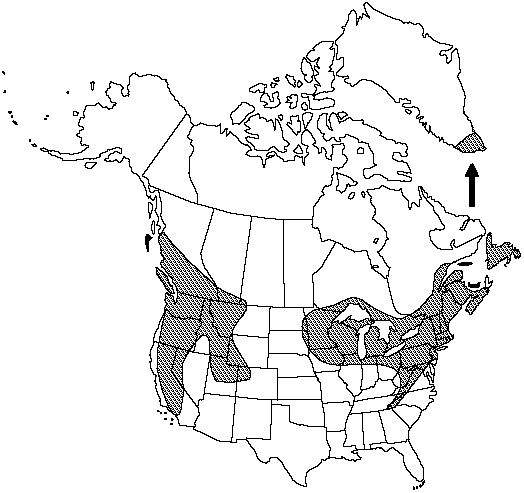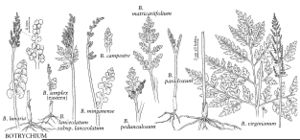Difference between revisions of "Botrychium simplex"
Amer. J. Sci. 6: 103, plate 8. 1823.
FNA>Volume Importer |
imported>Volume Importer |
||
| (7 intermediate revisions by 2 users not shown) | |||
| Line 8: | Line 8: | ||
}} | }} | ||
|common_names=Least moonwort;botryche simple | |common_names=Least moonwort;botryche simple | ||
| + | |special_status={{Treatment/ID/Special_status | ||
| + | |code=F | ||
| + | |label=Illustrated | ||
| + | }} | ||
|basionyms= | |basionyms= | ||
|synonyms={{Treatment/ID/Synonym | |synonyms={{Treatment/ID/Synonym | ||
|name=Botrychium tenebrosum | |name=Botrychium tenebrosum | ||
|authority=A.A. Eaton | |authority=A.A. Eaton | ||
| + | |rank=species | ||
}} | }} | ||
|hierarchy=Ophioglossaceae;Botrychium;Botrychium subg. Botrychium;Botrychium simplex | |hierarchy=Ophioglossaceae;Botrychium;Botrychium subg. Botrychium;Botrychium simplex | ||
| Line 20: | Line 25: | ||
}}<!-- | }}<!-- | ||
| − | --><span class="statement" id="st- | + | --><span class="statement" id="st-undefined" data-properties=""><b>Trophophore </b>stalk 0–3 cm, 0–1.5 times length of trophophore rachis; blade dull to bright green to whitish green, linear to ovate-oblong to oblong to fully triangular with pinnae arranged ternately, simple to 2(–3)-pinnate, to 7 × 0.2 cm, fleshy to thin, papery or herbaceous. <b>Pinnae</b> or well-developed lobes to 7 pairs, spreading to ascending, approximate to widely separated, distance between 1st and 2d pinnae frequently greater than between 2d and 3d pairs, basal pinna pair commonly much larger and more complex than adjacent pair, cuneate to fan-shaped, strongly asymmetric, undivided to divided to tip, basiscopic margins ± perpendicular to rachis, acroscopic margins strongly ascending, basal pinnae often divided into 2 unequal parts, margins usually entire or shallowly sinuate, apex rounded, undivided and boat-shaped to strongly divided and plane, venation pinnate or like ribs of fan, with midrib. <b>Sporophores</b> mainly 1-pinnate, 1–8 times length of trophophores. <b>2n</b> =90.</span><!-- |
-->{{Treatment/Body | -->{{Treatment/Body | ||
| + | |phenology=Leaves appearing midspring to early fall. | ||
|habitat=Dry fields, marshes, bogs, swamps, roadside ditches | |habitat=Dry fields, marshes, bogs, swamps, roadside ditches | ||
|elevation=0–2200 m | |elevation=0–2200 m | ||
| − | |distribution=Greenland;Alta.;B.C.;N.B.;Nfld.;N.S.;Ont.;Que.;Sask.;Calif.;Colo.;Conn.;Del.;D.C.;Idaho;Ill.;Ind.;Iowa;Maine;Md.;Mass.;Mich.;Minn.;Mont.;Nev.;N.H.;N.J.;N.Y.;N.C.;Ohio;Oreg.;Pa.;R.I.;Utah;Vt.;Va.;Wash.;W.Va.;Wis.;Wyo.;Europe. | + | |distribution=Greenland;Alta.;B.C.;N.B.;Nfld. and Labr. (Nfld.);N.S.;Ont.;Que.;Sask.;Calif.;Colo.;Conn.;Del.;D.C.;Idaho;Ill.;Ind.;Iowa;Maine;Md.;Mass.;Mich.;Minn.;Mont.;Nev.;N.H.;N.J.;N.Y.;N.C.;Ohio;Oreg.;Pa.;R.I.;Utah;Vt.;Va.;Wash.;W.Va.;Wis.;Wyo.;Europe. |
| − | |discussion=<p>The many environmental forms and juvenile stages of Botrychium simplex have resulted in the naming of numerous, mostly taxonomically worthless, infraspecific taxa. The western montane populations in the flora from Colorado to north Saskatchewan and westard are evidently distinctive, however, and may warrant subspecies or species status.</p><!-- | + | |discussion=<p>The many environmental forms and juvenile stages of <i>Botrychium simplex</i> have resulted in the naming of numerous, mostly taxonomically worthless, infraspecific taxa. The western montane populations in the flora from Colorado to north Saskatchewan and westard are evidently distinctive, however, and may warrant subspecies or species status.</p><!-- |
--><p>Mature, full-sized plants of these can be distinguished as follows:</p><!-- | --><p>Mature, full-sized plants of these can be distinguished as follows:</p><!-- | ||
| − | --><p>Eastern Botrychium simplex: Sporophore 1–4 times length of trophophores, arising from well-developed common stalk from below middle to near top, well above leaf sheath; trophophore nonternate or if subternate, lateral pinnae smaller than central pinnae and simple to merely lobed (rarely pinnate); pinnae usually adnate to rachis, rounded and ovate to spatulate, segment sides at angles mostly less than 90°; trophophore tip undivided; texture papery to herbaceous; common in upland fields.</p><!-- | + | --><p>Eastern <i>Botrychium simplex</i>: Sporophore 1–4 times length of trophophores, arising from well-developed common stalk from below middle to near top, well above leaf sheath; trophophore nonternate or if subternate, lateral pinnae smaller than central pinnae and simple to merely lobed (rarely pinnate); pinnae usually adnate to rachis, rounded and ovate to spatulate, segment sides at angles mostly less than 90°; trophophore tip undivided; texture papery to herbaceous; common in upland fields.</p><!-- |
| − | --><p>Western Botrychium simplex: Sporophore 3–8 times length of trophophore, mostly arising directly from top of leaf sheath, common stalk much reduced to absent; trophophore ternate with 3 equal segments (rarely nonternate, then resembling single segment of ternate blade); pinnae usually strongly contracted at base to stalked, angular to fan-shaped, segment sides at angles mostly more than 90°, like those of B. lunaria; trophophore tip divided, usually in 3 parts including narrow central lobe; texture thin, herbaceous; habitats mainly along marshy margins and in meadows.</p><!-- | + | --><p>Western <i>Botrychium simplex</i>: Sporophore 3–8 times length of trophophore, mostly arising directly from top of leaf sheath, common stalk much reduced to absent; trophophore ternate with 3 equal segments (rarely nonternate, then resembling single segment of ternate blade); pinnae usually strongly contracted at base to stalked, angular to fan-shaped, segment sides at angles mostly more than 90°, like those of <i>B. lunaria</i>; trophophore tip divided, usually in 3 parts including narrow central lobe; texture thin, herbaceous; habitats mainly along marshy margins and in meadows.</p><!-- |
| − | --><p>The eastern, typical Botrychium simplex has a common woodland and swamp shade form (B. tenebrosum A.A. Eaton) that appears to be a persistent juvenile. It is small and extremely slender, the trophophore simple, rudimentary, and attached near the top of an exaggerated common stalk. Many intermediates between this and more typical forms exist, however, and the variation appears to be the result of different growing conditions. The persistent western juvenile counterpart differs in the generally lower attachment of the trophophore (not necessarily on the top of the sheath), greater length of the trophophore, and more herbaceous texture.</p> | + | --><p>The eastern, typical <i>Botrychium simplex</i> has a common woodland and swamp shade form (B. tenebrosum A.A. Eaton) that appears to be a persistent juvenile. It is small and extremely slender, the trophophore simple, rudimentary, and attached near the top of an exaggerated common stalk. Many intermediates between this and more typical forms exist, however, and the variation appears to be the result of different growing conditions. The persistent western juvenile counterpart differs in the generally lower attachment of the trophophore (not necessarily on the top of the sheath), greater length of the trophophore, and more herbaceous texture.</p> |
|tables= | |tables= | ||
|references= | |references= | ||
| Line 39: | Line 45: | ||
-->{{#Taxon: | -->{{#Taxon: | ||
name=Botrychium simplex | name=Botrychium simplex | ||
| − | |||
|authority=E. Hitchcock | |authority=E. Hitchcock | ||
|rank=species | |rank=species | ||
| Line 46: | Line 51: | ||
|basionyms= | |basionyms= | ||
|family=Ophioglossaceae | |family=Ophioglossaceae | ||
| + | |phenology=Leaves appearing midspring to early fall. | ||
|habitat=Dry fields, marshes, bogs, swamps, roadside ditches | |habitat=Dry fields, marshes, bogs, swamps, roadside ditches | ||
|elevation=0–2200 m | |elevation=0–2200 m | ||
| − | |distribution=Greenland;Alta.;B.C.;N.B.;Nfld.;N.S.;Ont.;Que.;Sask.;Calif.;Colo.;Conn.;Del.;D.C.;Idaho;Ill.;Ind.;Iowa;Maine;Md.;Mass.;Mich.;Minn.;Mont.;Nev.;N.H.;N.J.;N.Y.;N.C.;Ohio;Oreg.;Pa.;R.I.;Utah;Vt.;Va.;Wash.;W.Va.;Wis.;Wyo.;Europe. | + | |distribution=Greenland;Alta.;B.C.;N.B.;Nfld. and Labr. (Nfld.);N.S.;Ont.;Que.;Sask.;Calif.;Colo.;Conn.;Del.;D.C.;Idaho;Ill.;Ind.;Iowa;Maine;Md.;Mass.;Mich.;Minn.;Mont.;Nev.;N.H.;N.J.;N.Y.;N.C.;Ohio;Oreg.;Pa.;R.I.;Utah;Vt.;Va.;Wash.;W.Va.;Wis.;Wyo.;Europe. |
|reference=None | |reference=None | ||
|publication title=Amer. J. Sci. | |publication title=Amer. J. Sci. | ||
|publication year=1823 | |publication year=1823 | ||
| − | |special status= | + | |special status=Illustrated |
| − | |source xml=https:// | + | |source xml=https://bitbucket.org/aafc-mbb/fna-data-curation/src/2e0870ddd59836b60bcf96646a41e87ea5a5943a/coarse_grained_fna_xml/V2/V2_408.xml |
|genus=Botrychium | |genus=Botrychium | ||
|subgenus=Botrychium subg. Botrychium | |subgenus=Botrychium subg. Botrychium | ||
|species=Botrychium simplex | |species=Botrychium simplex | ||
| − | |||
| − | |||
| − | |||
| − | |||
| − | |||
| − | |||
| − | |||
| − | |||
| − | |||
| − | |||
| − | |||
| − | |||
| − | |||
| − | |||
| − | |||
| − | |||
| − | |||
| − | |||
| − | |||
| − | |||
| − | |||
| − | |||
| − | |||
| − | |||
| − | |||
| − | |||
| − | |||
| − | |||
| − | |||
| − | |||
| − | |||
}}<!-- | }}<!-- | ||
-->[[Category:Treatment]][[Category:Botrychium subg. Botrychium]] | -->[[Category:Treatment]][[Category:Botrychium subg. Botrychium]] | ||
Latest revision as of 21:23, 5 November 2020
Trophophore stalk 0–3 cm, 0–1.5 times length of trophophore rachis; blade dull to bright green to whitish green, linear to ovate-oblong to oblong to fully triangular with pinnae arranged ternately, simple to 2(–3)-pinnate, to 7 × 0.2 cm, fleshy to thin, papery or herbaceous. Pinnae or well-developed lobes to 7 pairs, spreading to ascending, approximate to widely separated, distance between 1st and 2d pinnae frequently greater than between 2d and 3d pairs, basal pinna pair commonly much larger and more complex than adjacent pair, cuneate to fan-shaped, strongly asymmetric, undivided to divided to tip, basiscopic margins ± perpendicular to rachis, acroscopic margins strongly ascending, basal pinnae often divided into 2 unequal parts, margins usually entire or shallowly sinuate, apex rounded, undivided and boat-shaped to strongly divided and plane, venation pinnate or like ribs of fan, with midrib. Sporophores mainly 1-pinnate, 1–8 times length of trophophores. 2n =90.
Phenology: Leaves appearing midspring to early fall.
Habitat: Dry fields, marshes, bogs, swamps, roadside ditches
Elevation: 0–2200 m
Distribution

Greenland, Alta., B.C., N.B., Nfld. and Labr. (Nfld.), N.S., Ont., Que., Sask., Calif., Colo., Conn., Del., D.C., Idaho, Ill., Ind., Iowa, Maine, Md., Mass., Mich., Minn., Mont., Nev., N.H., N.J., N.Y., N.C., Ohio, Oreg., Pa., R.I., Utah, Vt., Va., Wash., W.Va., Wis., Wyo., Europe.
Discussion
The many environmental forms and juvenile stages of Botrychium simplex have resulted in the naming of numerous, mostly taxonomically worthless, infraspecific taxa. The western montane populations in the flora from Colorado to north Saskatchewan and westard are evidently distinctive, however, and may warrant subspecies or species status.
Mature, full-sized plants of these can be distinguished as follows:
Eastern Botrychium simplex: Sporophore 1–4 times length of trophophores, arising from well-developed common stalk from below middle to near top, well above leaf sheath; trophophore nonternate or if subternate, lateral pinnae smaller than central pinnae and simple to merely lobed (rarely pinnate); pinnae usually adnate to rachis, rounded and ovate to spatulate, segment sides at angles mostly less than 90°; trophophore tip undivided; texture papery to herbaceous; common in upland fields.
Western Botrychium simplex: Sporophore 3–8 times length of trophophore, mostly arising directly from top of leaf sheath, common stalk much reduced to absent; trophophore ternate with 3 equal segments (rarely nonternate, then resembling single segment of ternate blade); pinnae usually strongly contracted at base to stalked, angular to fan-shaped, segment sides at angles mostly more than 90°, like those of B. lunaria; trophophore tip divided, usually in 3 parts including narrow central lobe; texture thin, herbaceous; habitats mainly along marshy margins and in meadows.
The eastern, typical Botrychium simplex has a common woodland and swamp shade form (B. tenebrosum A.A. Eaton) that appears to be a persistent juvenile. It is small and extremely slender, the trophophore simple, rudimentary, and attached near the top of an exaggerated common stalk. Many intermediates between this and more typical forms exist, however, and the variation appears to be the result of different growing conditions. The persistent western juvenile counterpart differs in the generally lower attachment of the trophophore (not necessarily on the top of the sheath), greater length of the trophophore, and more herbaceous texture.
Selected References
None.
